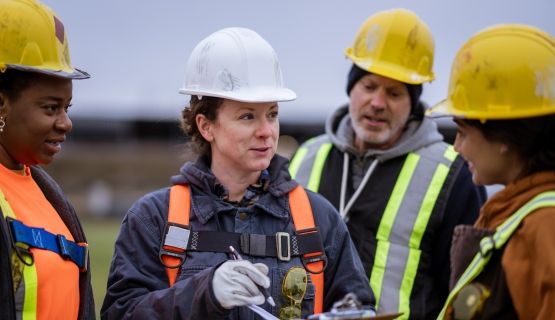Illness/injury prevention
IWH has a long history of conducting research to provide practical guidance to employers, workers, OHS professionals and regulators about what works and what doesn’t in injury or illness prevention. This research targets the injury and illness prevention practices of workplaces, as well as the programs developed by governments, health and safety associations and others to support and motivate workplaces to adopt effective practices.
Featured

At Work article
Differences in firm-level AI use for health and safety
To what extent are Canadian workplaces using artificial intelligence (AI) to help support workers’ health and safety? And what do these workplaces have in common? An IWH study surveyed firms across Ontario and British Columbia to find out.
Published: October 8, 2025

Impact case study
Saskatchewan’s construction safety group uses IWH tool to improve safety culture
This case study details how the Saskatchewan Construction Safety Association (SCSA) members have been analyzing IWH-OPM scores to adjust their safety practices and how SCSA has been using the data to tailor their outreach.
Published: February 10, 2025

Impact case study
Health and safety association uses regional injury rates to target services
Knowledge exchanges across the prevention system helps research findings reach front-line consultants and shape service delivery model.
Published: September 2009
Journal article
Journal article
A systematic review of occupational health and safety interventions with economic analyses
Published: Journal of Occupational and Environmental Medicine, September 2009

Issue Briefing
“Newness” and the risk of occupational injury
Research is emerging that “newness” is associated with a higher risk of work injury. Whether it’s young workers, workers of all ages new to their jobs, recent immigrants or employees in newly established firms, the evidence indicates that these workers face higher injury rates and/or more hazardous jobs. This Issue Briefing summarizes the key research behind these findings and explores the implications for policy-makers and health and safety service providers.
Published: May 2009

Sharing Best Evidence
Do workplace programs protect upper extremity musculoskeletal health?
Injuries to the upper extremity are common among workers, accounting for about 30 per cent of lost-time claims in Ontario in 2006. The upper extremity includes the neck, shoulder, upper arm, elbow, forearm, wrist and hand. This systematic review looked at the effectiveness of interventions to prevent upper extremity disorders and traumatic injuries.
Published: February 2009

Sharing Best Evidence
Are workplace prevention programs effective?
Injury/illness prevention and loss control programs (IPCs) help protect workers from injuries, meet regulatory requirements, reduce the negative effects of injuries and manage costs. IPCs include the three Ps: work practices among employees, policies developed by employers and programs required by legislation. This systematic review has shown that there is strong evidence supporting the effectiveness of disability management/return-to-work programs.
Published: December 2008
Systematic Review
Systematic Review
Systematic review of the role of occupational health and safety interventions in the prevention of upper extremity musculoskeletal symptoms, signs, disorders, injuries, claims and lost time
Injuries to the upper extremity are common among workers, accounting for about 30 per cent of lost-time claims in Ontario in 2006. The upper extremity includes the neck, shoulder, upper arm, elbow, forearm, wrist and hand. The systematic review described in this report looked at the effectiveness of interventions to prevent upper extremity disorders and traumatic injuries. Note that this systematic review was updated in 2016.
Published: December 2008
Systematic Review
Systematic Review
Effectiveness and implementation of health and safety programs in small enterprises: a systematic review of quantitative and qualitative literature
Small businesses have unique challenges with occupational health and safety (OHS). Overall, workers in small business have a higher risk of injury than workers in large firms, yet small-business owners and their workers may not have a sense of this increased risk because a work injury in any one small workplace is relatively rare. This reports shares the findings of a systematic review conducted to provide an understanding of, and guidance on, how to implement OHS in small businesses and what OHS programs are most likely to work.
Published: December 2008
Journal article
Journal article
Effectiveness of participatory ergonomic interventions on health outcomes: a systematic review
Published: Applied Ergonomics, May 2008

Sharing Best Evidence
Improving health and safety in small businesses
Small businesses have unique challenges with occupational health and safety (OHS). This systematic review was conducted to provide an understanding of, and guidance on, how to implement OHS in small businesses, and to identify effective OHS programs.
Published: January 2008
Project
Project
IWH Organizational Performance Metric: Developing and evaluating a simple workplace OHS tool
Status: Completed 2018